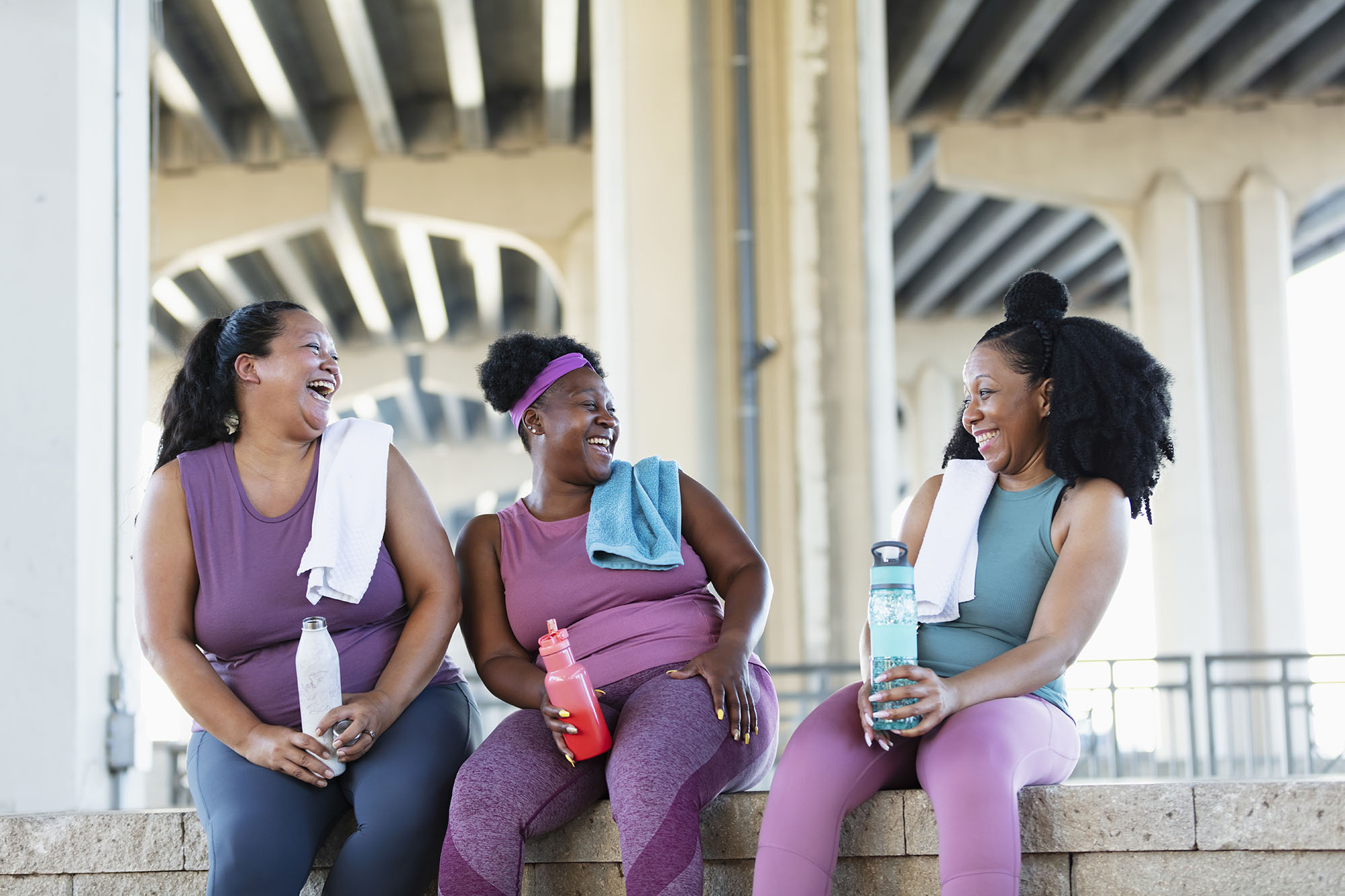
Weight gain in menopause: why it happens and how to manage it
Weight gain in menopause: why it happens and how to manage it

Of the many symptoms experienced in perimenopause, weight gain is often the most frustrating.
Around 60–70% of women gain weight between the ages of 50 and 60, often accompanied by a rise in fat mass and a loss of muscle mass.[1],[2] The increase in fat mass – often combined with bone density loss – can increase the risk of cardiovascular concerns. It can also take a toll on self-esteem and mood.
Fortunately, menopausal weight gain can be minimised through nutritional intervention and lifestyle changes.
Why do women gain weight during menopause?
Perimenopause is the transitional period before menopause, in which the ovaries gradually stop producing eggs and levels of estrogen and progesterone decline. The reduction in estrogen contributes to various symptoms such as mood changes, hot flushes, vaginal dryness, and insomnia. Physical changes include increased fat mass, decreased lean body mass, along with increased bone resorption, which can lead to bone loss.[3]
Weight gain occurs during this period for several reasons:
-
Loss of muscle and lean tissue
Reduced estrogen may increase muscle breakdown while slowing muscle-building. This increases the body’s demand for protein, which can increase appetite, but can also lower energy requirements, making weight gain more likely.[4]
With age, muscles respond less effectively to protein intake (a process known as anabolic resistance), which can mean that excess calories are more likely to be stored as fat rather than used to build muscle.[5]
-
Changes in blood sugar regulation
Lower estrogen reduces insulin sensitivity in muscles, making glucose uptake less efficient. This may contribute to insulin resistance and a lower resting energy expenditure.[6] Excess glucose is more likely to be stored as fat, and postmenopausal women often have higher postprandial glycaemic responses, which means blood sugar levels rise more sharply after meals and stay elevated for longer.[7]
-
Poor sleep and altered eating patterns
Menopausal symptoms can disrupt sleep patterns, which has also been linked to weight gain.[8] Both chronic and acute sleep restriction can reduce concentrations of leptin (the hormone involved in suppressing appetite) and increase ghrelin, the hormone that stimulates appetite and increases food intake.[9]
-
Microbiome changes
Estrogen also influences the gut microbiome, and declining levels during menopause can alter microbial diversity.
Gut microbiome dysbiosis due to reduced diversity and increased levels of pathogenic bacteria has been observed after menopause, which in turn has been linked to increased inflammation and metabolic dysfunction.[10]
Visceral adiposity (abdominal fat) in postmenopausal women has been linked to higher levels of both pro-inflammatory bacteria and harmful bacterial toxins, indicating that gut dysbiosis may lead to both adiposity and inflammation.[11]
Evidence-based strategies
Many women try to lose weight through dieting. However, restricted calorie intake during and post-menopause can further accelerate bone and muscle loss.[12] Instead, healthy and sustainable lifestyle changes can manage weight while supporting overall health.
-
Increase protein intake
Research suggests that increased protein intake combined with regular exercise can minimise weight gain in perimenopause.[13] Eating 1-2g protein per kg body weight combined with regular exercise (including free weights or resistance training) has been shown to help women maintain or increase lean body mass both during and post-menopause.[14],[15] For a 65 kg woman, this would be around 65-130 g protein per day. Protein is more satisfying than fat or simple carbohydrates, and higher intake can help maintain calorie burn while at rest, as well as increasing thermic effect (energy used to digest and process food).[16]
-
Exercise
Physical exercise during menopause can not only help in managing weight but improve cardiovascular health, preserve bone density, and improve sleep patterns and mood.[17]
Combining aerobic and resistance training appears to be more beneficial for reducing fat mass, retaining muscle and supporting bone density. Resistance training – using free weights, weight machines, bodyweight exercises, and elastic resistance bands – can improve glucose and fat metabolism, increase lean body mass and indirectly improve the body fat ratio.[18]
A 2022 study found that women who received intensive mentoring along with individualised diet intervention and intensified resistance exercise over three months showed the most improvement in body fat, waist circumference, and skeletal muscle weight.[19] Participants did resistance training twice a week (30-40 minutes of upper and lower body exercises) plus aerobic activity at least twice a week, aiming for 8,000–10,000 steps daily.
-
Support gut health
Blood glucose is closely related to the gut microbiota. Probiotic gut bacteria generate bioactive metabolites such as short-chain fatty acids and bile acids that support glucose metabolism, insulin signalling pathways, and gut barrier stability, all of which contribute to healthy blood sugar levels.[20]
A 2023 study found that multispecies probiotics significantly reduced both fasting and postprandial glucose and lipid profiles in adults with type 1 diabetes.[21] Similarly, a 2020 study showed that supplementing with Bifidobacterium infantis and other species significantly improved postprandial blood glucose.[22]
Supporting gut health with a high-fibre diet – including prebiotics – can also contribute to healthy weight management and/or weight loss.[23]
Perimenopause affects every woman differently, especially in terms of weight. But with a balanced diet, regular movement, and support for gut health, it can be easier to manage how your body changes.
This information is provided for educational purposes only and is not a substitute for professional medical advice. Always seek the guidance of your physician or qualified healthcare provider with any questions you may have regarding your health or a medical condition.
References
[1] Baker FC, Lampio L, Saaresranta T, Polo-Kantola P. Sleep and Sleep Disorders in the Menopausal Transition. Sleep Med Clin. 2018 Sep;13(3):443-456. doi: 10.1016/j.jsmc.2018.04.011. PMID: 30098758; PMCID: PMC6092036.
[2] Volpi E, Nazemi R, Fujita S. Muscle tissue changes with aging. Curr Opin Clin Nutr Metab Care. 2004 Jul;7(4):405-10. doi: 10.1097/01.mco.0000134362.76653.b2. PMID: 15192443; PMCID: PMC2804956.
[3] Greendale GA, Sternfeld B, Huang M, Han W, Karvonen-Gutierrez C, Ruppert K, Cauley JA, Finkelstein JS, Jiang SF, Karlamangla AS. Changes in body composition and weight during the menopause transition. JCI Insight. 2019 Mar 7;4(5):e124865. doi: 10.1172/jci.insight.124865. PMID: 30843880; PMCID: PMC6483504.
[4] Martinez JA, Wertheim BC, Thomson CA, Bea JW, Wallace R, Allison M, Snetselaar L, Chen Z, Nassir R, Thompson PA. Physical Activity Modifies the Association between Dietary Protein and Lean Mass of Postmenopausal Women. J Acad Nutr Diet. 2017 Feb;117(2):192-203.e1. doi: 10.1016/j.jand.2016.10.009. Epub 2016 Nov 30. PMID: 27914915; PMCID: PMC5276713.
[5] Hodson N, West DWD, Philp A, Burd NA, Moore DR. Molecular regulation of human skeletal muscle protein synthesis in response to exercise and nutrients: a compass for overcoming age-related anabolic resistance. Am J Physiol Cell Physiol. 2019 Dec 1;317(6):C1061-C1078. doi: 10.1152/ajpcell.00209.2019. Epub 2019 Aug 28. PMID: 31461340; PMCID: PMC6962519.
[6] Mauvais-Jarvis F. Estrogen and androgen receptors: regulators of fuel homeostasis and emerging targets for diabetes and obesity. Trends Endocrinol Metab. 2011 Jan;22(1):24-33. doi: 10.1016/j.tem.2010.10.002. Epub 2010 Nov 5. PMID: 21109497; PMCID: PMC3011051.
[7] Bermingham KM, Linenberg I, Hall WL, Kadé K, Franks PW, Davies R, Wolf J, Hadjigeorgiou G, Asnicar F, Segata N, Manson JE, Newson LR, Delahanty LM, Ordovas JM, Chan AT, Spector TD, Valdes AM, Berry SE. Menopause is associated with postprandial metabolism, metabolic health and lifestyle: The ZOE PREDICT study. EBioMedicine. 2022 Nov;85:104303. doi: 10.1016/j.ebiom.2022.104303. Epub 2022 Oct 18. PMID: 36270905; PMCID: PMC9669773.
[8] Fenton A. Weight, Shape, and Body Composition Changes at Menopause. J Midlife Health. 2021 Jul-Sep;12(3):187-192. doi: 10.4103/jmh.jmh_123_21. Epub 2021 Oct 16. PMID: 34759699; PMCID: PMC8569454.
[9] Figueiro MG, Plitnick B, Rea MS. Light modulates leptin and ghrelin in sleep-restricted adults. Int J Endocrinol. 2012;2012:530726. doi: 10.1155/2012/530726. Epub 2012 Aug 14. PMID: 22988459; PMCID: PMC3440859.
[10] Mazidi M, Valdes AM, Ordovas JM, Hall WL, Pujol JC, Wolf J, Hadjigeorgiou G, Segata N, Sattar N, Koivula R, Spector TD, Franks PW, Berry SE. Meal-induced inflammation: postprandial insights from the Personalised REsponses to DIetary Composition Trial (PREDICT) study in 1000 participants. Am J Clin Nutr. 2021 Sep 1;114(3):1028-1038. doi: 10.1093/ajcn/nqab132. PMID: 34100082; PMCID: PMC8408875.
[11] Gaber, M., Wilson, A.S., Millen, A.E. et al. Visceral adiposity in postmenopausal women is associated with a pro-inflammatory gut microbiome and immunogenic metabolic endotoxemia. Microbiome 12, 192 (2024). https://doi.org/10.1186/s40168-024-01901-1
[12] Hulteen RM, Marlatt KL, Allerton TD, Lovre D. Detrimental Changes in Health during Menopause: The Role of Physical Activity. Int J Sports Med. 2023 Jun;44(6):389-396. doi: 10.1055/a-2003-9406. Epub 2023 Feb 17. PMID: 36807278; PMCID: PMC10467628.
[13] Martinez JA, Wertheim BC, Thomson CA, Bea JW, Wallace R, Allison M, Snetselaar L, Chen Z, Nassir R, Thompson PA. Physical Activity Modifies the Association between Dietary Protein and Lean Mass of Postmenopausal Women. J Acad Nutr Diet. 2017 Feb;117(2):192-203.e1. doi: 10.1016/j.jand.2016.10.009. Epub 2016 Nov 30. PMID: 27914915; PMCID: PMC5276713.
[14] Thomas DR. Loss of skeletal muscle mass in aging: examining the relationship of starvation, sarcopenia and cachexia. Clin Nutr. 2007 Aug;26(4):389-99. doi: 10.1016/j.clnu.2007.03.008. Epub 2007 May 11. PMID: 17499396.
[15] Martinez JA, Wertheim BC, Thomson CA, Bea JW, Wallace R, Allison M, Snetselaar L, Chen Z, Nassir R, Thompson PA. Physical Activity Modifies the Association between Dietary Protein and Lean Mass of Postmenopausal Women. J Acad Nutr Diet. 2017 Feb;117(2):192-203.e1. doi: 10.1016/jLi J, Armstrong CL, Campbell WW. Effects of Dietary Protein Source and Quantity during Weight Loss on Appetite, Energy Expenditure, and Cardio-Metabolic Responses. Nutrients. 2016 Jan 26;8(2):63. doi: 10.3390/nu8020063. PMID: 26821042; PMCID: PMC4772027. .jand.2016.10.009. Epub 2016 Nov 30. PMID: 27914915; PMCID: PMC5276713.
[16] Li J, Armstrong CL, Campbell WW. Effects of Dietary Protein Source and Quantity during Weight Loss on Appetite, Energy Expenditure, and Cardio-Metabolic Responses. Nutrients. 2016 Jan 26;8(2):63. doi: 10.3390/nu8020063. PMID: 26821042; PMCID: PMC4772027.
[17] Hulteen RM, Marlatt KL, Allerton TD, Lovre D. Detrimental Changes in Health during Menopause: The Role of Physical Activity. Int J Sports Med. 2023 Jun;44(6):389-396. doi: 10.1055/a-2003-9406. Epub 2023 Feb 17. PMID: 36807278; PMCID: PMC10467628.
[18] Hao S, Tan S, Li J, Li W, Li J, Cai X, Hong Z. Dietary and Exercise Interventions for Perimenopausal Women: A Health Status Impact Study. Front Nutr. 2022 Jan 27;8:752500. doi: 10.3389/fnut.2021.752500. PMID: 35155511; PMCID: PMC8828936.
[19] Hao S, Tan S, Li J, Li W, Li J, Cai X, Hong Z. Dietary and Exercise Interventions for Perimenopausal Women: A Health Status Impact Study. Front Nutr. 2022 Jan 27;8:752500. doi: 10.3389/fnut.2021.752500. PMID: 35155511; PMCID: PMC8828936.
[20] Feng X, Deng M, Zhang L, Pan Q. Impact of gut microbiota and associated mechanisms on postprandial glucose levels in patients with diabetes. J Transl Int Med. 2023 Dec 20;11(4):363-371. doi: 10.2478/jtim-2023-0116. PMID: 38130636; PMCID: PMC10732577.
[21] Zhang X, Zhang Y, Luo L, Le Y, Li Y, Yuan F, Wu Y, Xu P. The Beneficial Effects of a Multispecies Probiotic Supplement on Glycaemic Control and Metabolic Profile in Adults with Type 1 Diabetes: A Randomised, Double-Blinded, Placebo-Controlled Pilot-Study. Diabetes Metab Syndr Obes. 2023 Mar 18;16:829-840. doi: 10.2147/DMSO.S400119. PMID: 36970073; PMCID: PMC10032215.
[22] Perraudeau F, McMurdie P, Bullard J, Cheng A, Cutcliffe C, Deo A, Eid J, Gines J, Iyer M, Justice N, Loo WT, Nemchek M, Schicklberger M, Souza M, Stoneburner B, Tyagi S, Kolterman O. Improvements to postprandial glucose control in subjects with type 2 diabetes: a multicenter, double blind, randomized placebo-controlled trial of a novel probiotic formulation. BMJ Open Diabetes Res Care. 2020 Jul;8(1):e001319. doi: 10.1136/bmjdrc-2020-001319. PMID: 32675291; PMCID: PMC7368581.
[23] Kelly RK, Calhoun J, Hanus A, Payne-Foster P, Stout R, Sherman BW. Increased dietary fiber is associated with weight loss among Full Plate Living program participants. Front Nutr. 2023 Apr 17;10:1110748. doi: 10.3389/fnut.2023.1110748. PMID: 37139446; PMCID: PMC10150096.




